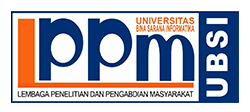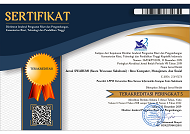OPTIMASI ALGORITMA KLASIFIKASI C4.5 BERBASIS PARTICLE SWARM OPTIMIZATION UNTUK PREDIKSI PENYAKIT JANTUNG
Abstract
based Particle Swarm Optimization (PSO) to find out how accurate the PSO feature selection to improve the accuracy of the C4.5 decision tree in predicting heart disease.The results for the accuracy of classification algorithm C4.5 worth 81,25%, whereas the accuracy for C4.5 classification algorithm based on PSO is worth 93,75% the value that is equal to 12,5% accuracy. While evaluation using ROC curve for both, the value of AUC by ROC curve for C4.5 classification algorithm is worth 0,718 with Fair diagnosis classification level, wheras for C4.5 classification algorithm based on PSO is worth 0,855 with Good Classification diagnosis rate, the difference in AUC values is 0,137. It can be concluded that the application of particle swarm optimization techniques can improve the accuracy of the algorithm C4.5.
Full Text:
PDF (Bahasa Indonesia)References
Bhuvaneswari, R., & Kalaiselvi, K. (2012). Naive Bayesian Classification Approach in Healthcare Applications.International Journal of Computer
Science and Telecommunications Volume 3, Issue 1, January , 106-112.
Bramer, M. (2007). Principles of Data Mining. London: Springer.
Chen, AH., et al. (2011). HDPS: Heart Disease Prediction System. Computing in Cardiology. 557-560
Cho, YJ., et al.(2011). Optimization of Decision Tree for Classification Using Particle Swarm. IEMS Vol. 10 No. 4 pp.272-278
Cohen, L., Manion, L., & Morrison, K. (2005). Research Methods in Education 5th Edition. London: The Taylor & Francis e-Library.
Davidson, Christopher. 2003. Penyakit Jantung Koroner. Jakarta: Dian Rakyat.
Eberhart, Russel C., Yuhui Shi. (2001). Particle Swarm Optimization:Developments,Application and Resources. 0-7803-6657-3/01. IEEE.
Gorunescu, Florin. (2011). Data Mining Concept, Model and Technique. Verlag Berlin Heidelberg: Springer.
Hermawati, Fajar Astuti. (2013). DATA MINING. Yogyakarta: Andi Offset.
Khan, M. G. (2005). Encyclopedia of Heart Diseases. New York: Academic Press.
Kothari, C. R. (2004). Research Methology Methods and Techniques. India: New Age International Limited.
Kumar, D. Senthil., Sathyadevi, G., & Sivanesh, S. (2011). Decision Support System for Medical Diagnosis UsingData Mining. International Journal of Computer Science Issues Vol.8, Issue 3, No 1, 147-153.
Kusrini, Emha Taufik Lutfi. (2009).ALGORITMA DATA MINING. Yogyakarta: Andi Offset.
Larose,T. Daniel. (2005). DISCOVERING KNOWLEDGE IN DATA: An Introduction to DATA MINING. New Jersey: John Wiley & Sons, Inc.
Larose, T. Daniel. (2006). DATA MINING: METHOD AND MODELS. New Jersey: John Wiley & Sons, Inc.
Nugroho, W. (2006). Komunikasi Dalam Keperawatan Gerontik. Jakarta: EGC.
Prasetyo, Eko. (2012). Data Mining: Konsep dan Aplikasi Menggunakan MATLAB. Yogyakarta: Andi Offsett.
Prodia. Dikutip 26 Juni 2013, dari Penyakit Jantung koroner:http://prodia.co.id/penyakit-dan-diagnosa/penyakit-jantung-koroner.
Rajkumar, A., & Reena, G. S. (September 2010). Diagnosis Of Heart Disease Using Data Mining Algorithm. Global Journal of Computer Science and
Technology, Vol. 10 Issue 10, 38-43.
Sloane, Ethel. (2004). ANATOMI DAN FISIOLOGI: Untuk Pemula. Jakarta:Penerbit Buku Kedokteran (EGC).
Sugiyanto. (2008). Metode Penelitian Kuantitatif Kualitatif dan R&D.Bandung:Alfabeta.
Tsai, MC., et al. (2012). An Application of PSO Algorithm and Decision Tree for Medical Problem. 2nd International Conference on Intelligent Computational System (ICS‟2012) Oct. 13-14, 2012 Bali-Indonesia.
University of California Irvine Machine Learning Repository. Dikutip 25 Juni 2013, darihttp://archive.ics.uci.edu/ml/machine-learning-databases/statlog/heart/heart.dat
Widodo, Pudjo Prabowo, et al. (2013). Penerapan Data Mining denganMATLAB. Bandung: Rekayasa Sains.
Wu, X., & Kumar, V. (2009). The Top Ten Algorithms in Data Mining. New York: CRC Press.
World Health Organization. (2013). Dikutip 29 Juni 2013, dari The Top 10 Causes of Death:http://www.who.int/mediacentre/factsheets/fs310/en/index.html
Zhan, ZH., et al (2010). Orthogonal Learning Particle Swarm Optimization. IEEE Transaction On Evolutionary Computation, 1089-778X
DOI: https://doi.org/10.31294/swabumi.v1i1.992
INDEXING

P-ISSN : 2355-990X E-ISSN: 2549-5178













